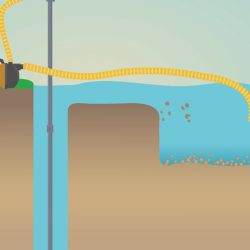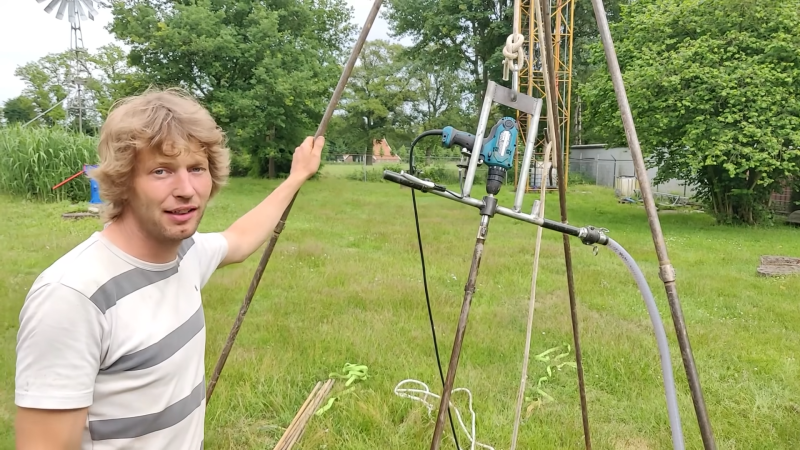There are a large number of methods commercially used to bore a hole into the ground for the sake of extracting drinking water, and the all require big loud equipment. But what if you just want a small well? Do you really have to call in the big guns? [The Working Group on Development Techniques] is a student association at the University of Twente in the Netherlands who shows in the video below the break that some simple homemade fixtures and a powerful hand drill are quite enough to do the job!

Chief among these fixtures is a swiveling mechanism that serves to hold the drill and its weight, give control over the drill, and inject water into the pipe that the drill bit is attached to. Plans for the swivel are made available on [WOT]’s website. What looks to be a DIY drill bit uses commercially available diamond tips for hardness.
What makes the video remarkable is that it discusses every stage of drilling the bore hole, lining it with casing, and then making it suitable for pumping water from. The video also discusses the chemicals and methods involved in successfully drilling the hole, and gives an overview of the process that also applies to commercially drilled wells.
Naturally you’ll want to make sure your drill is corded so that you can drill for long periods, but also so that it doesn’t grow wings and fly away!

















The best part is when he hits the halfway mark and breaks into the chorus of Livin’ On A Prayer.
It’s a well drilling drill because it drills wells well.
Well I never!
They drilled a hole in the Netherlands? Doesn’t that mean it will sink beneath the waves?
Not in that part of the country.
If I would try this in my back yard, though, I’d have to put my finger in the hole.
Finger? Why not have some fun with a middle leg instead?
Tss! We don’t do *that*!
Besides, we’re a farming nation, the animals wouldn’t have it.
Yeah, I thought in the Netherlands wells were drilled horizontally.
We drill them upwards actually ;)
In some parts of the netherlands a soft stamp with the heel of your shoe is all it takes to make a well.
The Dutch are really tall. Why? Did the short ones drown?
No, growing taller is to preparing them for sea level rise.
11’35: all these grinded plastic microparticles released in the environment…
Does he have a permit?
If you are using water as part of the drilling process how do you know when you hit water? Maybe not a question in that location.
I’ve watched relatives pound a well into the ground with a homemade hammer. It was just a heavy, iron pipe that fit over the pipe being hammered in. A cap was welded on one end and handles just in from there. The whole thing was suspended by a tripod made of logs dragged out of the woods and tied together with a pulley suspended from the top.
They just pulled a rope to lift the hammer, put it over the end of the pipe, let it slam down, repeat. When the pipe gets near the ground they would screw on another length. Every so often they would attach a handpump and check to see if they had struck water.
One reason I loved writing this article is because my father was a pump and well man. When I was 7 or 8 years old I went to work with him a few times and I recall a machine that did exactly that – lifted a big heavy bit, then dropped it. Again. Again. Boom. Boom.
It’s called a Cable Tool drilling, and it’s still done :)
Is there any way I can get specs for the mechanism that holds the drill? We live
in Florida and I think this would work for me.
When using mud (drilling fluid) you watch the volume of the mud pit close and know what you are drilling through. If you hit a sand or gravel formation and either loose or gain volume in the mud pit it can convey water and probably has it in the formation, so you can do a pump test there and pump out to see how much water you can produce. Most of the time unless you are drilling in places with springs you will loose mud because the hydrostatic pressure will push it into the formation. However areas with natural springs will usually overcome the pressure and you will gain water. In those situations you can also drop a temperature probe in the mud. If you hit a formation that produces water the return water temperature will drop due to the colder water entering the well. That way you don’t have to stop every few minutes and watch the mud pit to see if it’s gaining or loosing.